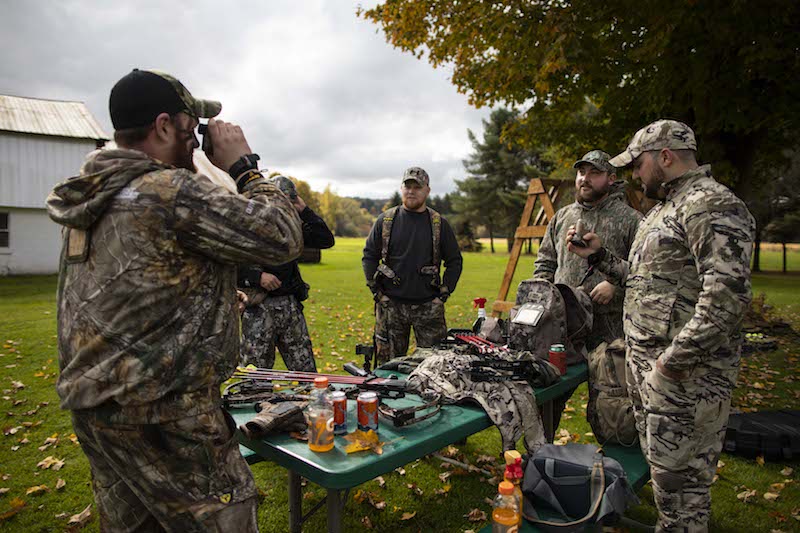Bowhunters: You Can Stay Warm in Cold Weather
Bowhunters often open their doors in late fall or early winter, only to get slapped by cold, bone-chilling air. It’s tempting to retreat and dive back under the covers, but cold-weather hunts are fun and often productive if you can bear the conditions.
With roughly half the hunting season left, many bowhunters have unfilled tags and freezers. We spoke to Devin Sweeney, general manager for NOMAD Outdoor, for his advice for staying warm through snow, wind and subfreezing temperatures.
During cold weather, it’s tempting to hurry to your stand and quickly climb aboard. But exerting yourself can cause overheating and sweating. As that sweat cools, you’ll start shivering, lose focus, and risk ruining your hunt.
It’s better to carry those extra layers while walking in, and finish dressing once you arrive. Let’s review other no-sweat tips for staying warm while bowhunting.
Layering 101

Start with a moisture wicking layer that will pull any sweat way from your body. Photo Credit: ATA
Layered clothing systems help you retain heat without sweating because you can remove layers when active and add layers when still. Sweeney recommends strategically wearing four layers throughout the hunt.
- Base or first layer: The base layer is thin, breathable and covers your skin. Sweeney recommends natural materials like wool or synthetics like polyester. These materials wick moisture and use antimicrobials to reduce human odors. Wear the base layer at all times.
- Second layer: This lightweight insulating layer should be breathable, and resist wind, dew and other moisture so you stay dry while walking to and from your stand. Polyester or merino wool sweatshirts or thin jackets work well. Wear this second layer for the walk in, and cover it with additional layers once you’re cooled and ready to sit.
- Third layer: This dense, insulating layer is usually thicker and fuzzier. Sweeney said good options include natural down from ducks or geese, or synthetic fibers like nylon or polyester. Sweeney said polyester is popular because it’s more easily printed with camouflage. Down is usually lighter and warmer than synthetic fibers, but it’s less effective when wet unless it’s hydrophobic. Carry this third layer to your hunting site and put it on once you’re ready to hunt. Don’t dress in your treestand. Let yourself cool off after you arrive. Next, put on your extra layers at the tree’s base, and climb slowly to your stand. Choose insulating layers with zippers, not buttons, so you can finish dressing without removing your gloves.
- Fourth layer: This is the outer shell. Choose a fleece-lined, windproof and waterproof piece to complete your clothing system. Outer shells are often bulky but necessary for warmth and protection from the elements. Pack it in. If it’s raining when you leave your truck, stuff this heavy layer into a waterproof bag or pack, and wear lightweight rain gear for the hike in.
Correct layering keeps you afield. “Your body can generate heat, and the base layer will wick moisture away from your skin,” Sweeney said. “Your second layer protects you from the elements as you walk to your stand. Once there, seal in that heat with the insulating layers and external shell, which act like an internal furnace to keep you warm.”
Sweeney recommends stuffing your third and fourth layers into a backpack for the walk in. Also, avoid cotton materials, which retain moisture. Wear good socks and gloves, and pack a warm stocking hat to slip over your ballcap. You’ll like the ballcap’s visor for shielding your eyes from rain, snow or bright sunlight.
If it’s subfreezing and you plan to sit all day, pack extra insulating layers. “The more layers you have, the more heat you can trap,” Sweeney said.
On a budget? Sweeney suggests buying a good outer shell. Most people can find the first three layers in their closets, whether the items are pink, yellow or plaid. Wash them in scent-free detergent and cover them with a camouflage outer shell.
More Ways to Stay Warm

Walk slowly to your stand to avoid sweating in the first place. Photo Credit: Additional Ways
- Take your time. Walk to your stand and climb to your stand slowly to prevent overheating and sweating.
- Use hand and foot warmers. These air-activated marvels generate sustained heat to help you sit longer.
- Focus on your feet. Sweeney said feet are usually the first thing to chill. Buy insulated boots and boot covers to shield your feet from your stand’s cold aluminum frame.
- Face the sun. If possible, face the sun throughout the day to keep its warm rays on your face, which is satisfying and comforting.
- Choose evening hunts. It’s usually warmer in the afternoon. Plus, you’ll cool off by sunset and be able to walk out quickly without sweating. Why? Because you likely won’t restore your core temperature until reaching your heated car, pickup or camp.
- Sit inside a box stand or ground blind. These structures trap heat and shelter you from the cold and wind. You can also use a portable gas heater if there’s room.
- Pack a thermos. Coffee or hot chocolate, anyone? Warm beverages lift your spirits and keep your hands toasty. Just don’t spill them!
Visit an archery retailer to find boots, clothes and accessories you need to stay warm in the cold woods.

